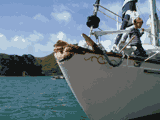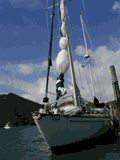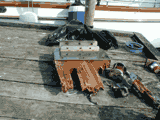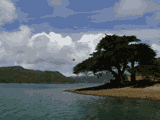Photo Gallery - December 2001
Pictures can be clicked to see a large
version of the image.
 On
December 3rd the Queen Jane was struck at sea by the freighter "Southern
Cross II". The collision occured at about 6:15pm (sunset was 8:30pm so it
was broad daylight). The damage was severe but the tough Shannon 50 shrugged it off
and motored to port under her own power. This is the ship involved. The photo
was taken about an hour after the accident.
On
December 3rd the Queen Jane was struck at sea by the freighter "Southern
Cross II". The collision occured at about 6:15pm (sunset was 8:30pm so it
was broad daylight). The damage was severe but the tough Shannon 50 shrugged it off
and motored to port under her own power. This is the ship involved. The photo
was taken about an hour after the accident.
 The
Queen Jane limping home with wreckage strewn across the bow (including the
furling job which could not be rolled up or lowered). This photo was also taken
about an hour after the accident. As you can see, the sea was very calm and
visibility good though cloudy and overcast.
The
Queen Jane limping home with wreckage strewn across the bow (including the
furling job which could not be rolled up or lowered). This photo was also taken
about an hour after the accident. As you can see, the sea was very calm and
visibility good though cloudy and overcast.
 Only
2 or 3 hours way, Nagle Cove on Great Barrier Island was to be our refuge. We
could not have asked for a more serene and peaceful place to recover our sanity
after this incredibly scary incident.
Only
2 or 3 hours way, Nagle Cove on Great Barrier Island was to be our refuge. We
could not have asked for a more serene and peaceful place to recover our sanity
after this incredibly scary incident.
 The
bow of the boat after some of the wreckage has been removed. A
"before" photo showing the bow platform and pulpit can be seen in the
November 2001 (Fiji) photogallery.
The
bow of the boat after some of the wreckage has been removed. A
"before" photo showing the bow platform and pulpit can be seen in the
November 2001 (Fiji) photogallery.
 A
close-up of the bow with debris still strewn about. Part of the bow pulpit can
be seen here looking more like a pretzel.
A
close-up of the bow with debris still strewn about. Part of the bow pulpit can
be seen here looking more like a pretzel.
 Kate
and Jonah take a walk along the beach at low tide at the beautiful and idyllic
Nagle Cove.
Kate
and Jonah take a walk along the beach at low tide at the beautiful and idyllic
Nagle Cove.
 The
incredible beauty and serenity of this place helped to speed our mental recovery
and calm our frayed nerves.
The
incredible beauty and serenity of this place helped to speed our mental recovery
and calm our frayed nerves.
 This
photo shows the smashed nose of the Shannon. Its hard to believe still that this
is all the damage sustained. The integrity of the hull was complete and so far
we have found no evidence of structual damage aside from this.
This
photo shows the smashed nose of the Shannon. Its hard to believe still that this
is all the damage sustained. The integrity of the hull was complete and so far
we have found no evidence of structual damage aside from this.
 The
process of clearing away the debris, stripping salvagable hardware, and
preparing the boat for the remainder of the trip to Tauranga began with small
steps. The first day at Nagle Cove the crew made little apparent progress due to
a general feeling of shock.
The
process of clearing away the debris, stripping salvagable hardware, and
preparing the boat for the remainder of the trip to Tauranga began with small
steps. The first day at Nagle Cove the crew made little apparent progress due to
a general feeling of shock.
 Another
shot showing the condition of the bow and genoa sail/furler. The first job was
to get the sail lashed down as the wind never went below 10k and the sail could
not be furled with the broken furler. We had to haul a man aloft (Paul, a local
bulldozer driver was on hand to assist one day while working our host's
property) to wrap ties around its bulky, billowing mass.
Another
shot showing the condition of the bow and genoa sail/furler. The first job was
to get the sail lashed down as the wind never went below 10k and the sail could
not be furled with the broken furler. We had to haul a man aloft (Paul, a local
bulldozer driver was on hand to assist one day while working our host's
property) to wrap ties around its bulky, billowing mass.
 Damage
to the port and stbd sides of the hull resulted from the mass of wreckage
flailing about in the first hours after the collision. Here you can see the
heavy damage to the stbd side toerail/caprail, rubrail and topsides.
Damage
to the port and stbd sides of the hull resulted from the mass of wreckage
flailing about in the first hours after the collision. Here you can see the
heavy damage to the stbd side toerail/caprail, rubrail and topsides.
 The
home of our hosts, Allen and Mary who have lived in Nagle Cove for 14 years.
They have 2 children who are driven to and from the school bus stop each day by
boat as the home is not reachable by any road.
The
home of our hosts, Allen and Mary who have lived in Nagle Cove for 14 years.
They have 2 children who are driven to and from the school bus stop each day by
boat as the home is not reachable by any road.
 The
Queen Jane at the end of the private pier at Nagle Cove. Allen came out (in a
40ft sportfishing boat called "Desiderata" owned and operated by
another island couple) to guide us into the cove
in pitch darkness and help us tie up to this pier.
The
Queen Jane at the end of the private pier at Nagle Cove. Allen came out (in a
40ft sportfishing boat called "Desiderata" owned and operated by
another island couple) to guide us into the cove
in pitch darkness and help us tie up to this pier.
 Mary,
Allen's wife, and Anne, a reporter from the New Zealand Herald. Anne (and
a photographer named Peter) were at Great Barrier Island doing a story
about families which live on the isolated island.
Mary,
Allen's wife, and Anne, a reporter from the New Zealand Herald. Anne (and
a photographer named Peter) were at Great Barrier Island doing a story
about families which live on the isolated island.
 Peter,
the photographer on assignment at the island with Anne. When Anne heard
about our experience she came by to interview us for a story in the paper. Since
she only got about 4 facts wrong I was quite pleased with the story.
Unfortunately the photos Peter shot never made it into the paper due to
difficulties in transmitting them via computer.
Peter,
the photographer on assignment at the island with Anne. When Anne heard
about our experience she came by to interview us for a story in the paper. Since
she only got about 4 facts wrong I was quite pleased with the story.
Unfortunately the photos Peter shot never made it into the paper due to
difficulties in transmitting them via computer.
 A
section of the bow platform. The platform was built of laminated teak strips
about 2" x 2" each and was over 5 feet long and about 2 feet wide. The
stbd. side anchor roller can be seen here (which we were able to salvage and
plan to reuse).
A
section of the bow platform. The platform was built of laminated teak strips
about 2" x 2" each and was over 5 feet long and about 2 feet wide. The
stbd. side anchor roller can be seen here (which we were able to salvage and
plan to reuse).
 The
forward-most section of the bow platform with "nose piece" still
attached. The nose piece, a complex piece of stainless steel fabrication was
also salvaged for reuse.
The
forward-most section of the bow platform with "nose piece" still
attached. The nose piece, a complex piece of stainless steel fabrication was
also salvaged for reuse.
 During
our second day of work a couple from Auckland who owns the property arrived via
helicopter to spend a fews days at their vacation home.
During
our second day of work a couple from Auckland who owns the property arrived via
helicopter to spend a fews days at their vacation home.
 The
chopper landing on the lawn provided a brief period of entertainment for the crew of 5 working to prep the boat for the trip to Tauranga.
The
chopper landing on the lawn provided a brief period of entertainment for the crew of 5 working to prep the boat for the trip to Tauranga.
 Steven
from the S/V Batrachian. Steven and his wife Katherine happened to be in the
next cove over and after learning of our situation came over early on the 4th to
assist with damage control and prep work. Steven and Katherine, whom we met in
July at Huahine in French Polynesia sail a Waukiez 48. Steve has a great deal of
experience with boats and boat building and was instrumental in prepping the
boat for sea.
Steven
from the S/V Batrachian. Steven and his wife Katherine happened to be in the
next cove over and after learning of our situation came over early on the 4th to
assist with damage control and prep work. Steven and Katherine, whom we met in
July at Huahine in French Polynesia sail a Waukiez 48. Steve has a great deal of
experience with boats and boat building and was instrumental in prepping the
boat for sea.
 Steven's
lovely wife Katherine (who also has a lovely name) was also a great help to
us.
Steven's
lovely wife Katherine (who also has a lovely name) was also a great help to
us.
 Anders
on watch on the way down to Tauranga. Anders flew to the island in a chartered
plane along with Brian, a local boat yard worker from Tauranga, to help make
temporary repairs and help bring the boat down with me. Kate and Jonah flew to
Tauranga on the same plane which brought Anders and Brian to the island.
Anders
on watch on the way down to Tauranga. Anders flew to the island in a chartered
plane along with Brian, a local boat yard worker from Tauranga, to help make
temporary repairs and help bring the boat down with me. Kate and Jonah flew to
Tauranga on the same plane which brought Anders and Brian to the island.
 A
statue just inside the harbor entrance at Tauranga. Apparently locals throw
coins at the statue as the leave the harbor to ensure good luck fishing. Brian
reported that it had failed to improve his luck though he always made an
offering regardless.
A
statue just inside the harbor entrance at Tauranga. Apparently locals throw
coins at the statue as the leave the harbor to ensure good luck fishing. Brian
reported that it had failed to improve his luck though he always made an
offering regardless.
 Mount
Mangenui guards the entrance to Tauranga Harbor. The almost flat-topped mountain
is ringed with trails and picnics and hiking on it are very popular.
Mount
Mangenui guards the entrance to Tauranga Harbor. The almost flat-topped mountain
is ringed with trails and picnics and hiking on it are very popular.
 The
new "Snub Nose" appearance is quite appaling to us.
The
new "Snub Nose" appearance is quite appaling to us.
We have nothing but praise and gratitude for the workers at
the Shannon Boat Company in Bristol, Rhode Island who built our Shannon 50. It
is quite clear that any lesser built boat would lie at the bottom of the Pacific
after having gone through what she experienced. We are truly convinced that only
her incredibly strong construction saved our lives. Only a well built steel boat
could have withstood such punishment and come away with so little relative
damage.
To Mr. Walt Shultz and everyone at Shannon, THANK YOU!
